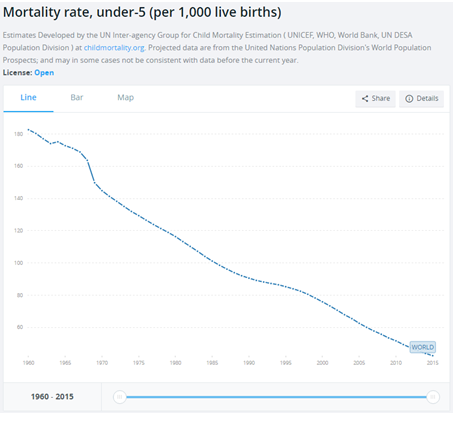Let’s start with the big picture – every year, nearly 7.6 million children will die before they turn five years old (UNICEF). That’s 7,600,000 children, just shy of the total population of a country the size of Israel, or Honduras, or the entire combined populations of Kansas, Nevada, and New Mexico. Imagine the scale of this problem. Imagine if EVERY year, these countries or states saw their entire population wiped out – each and every year, over and over again. Except it’s not an entire population, but exclusively the most vulnerable members of human society – poor children who aren’t even five years old yet.
This is, unfortunately, the world we find ourselves currently living in hard as it may seem. It is worth pausing here to note that the under-5 mortality (a measure of the probability of dying between birth and five years of age per 1,000 live births) is at its lowest ever, historically. We have a lot to be proud of in terms of how far we have come in the past half century below as the graph below indicates:

According to Save the Children’s State of the World’s Mothers 2012 (and can be found here), malnutrition is an underlying cause of death for nearly 2.6 million children each year. Malnutrition is a significant problem, not just because of the mortality rates it induces in young children and mothers but also because of the morbidity and suffering it causes to those who survive it. Every year, 20 million babies are born into this world with low birth weight, some because they are born too prematurely and others because of inadequate growth and nutrients while developing in the womb.
There are also economic factors impacted by malnutrition – adults who were malnourished as children earn an estimated 20% less on average over the course of their lives than those who weren’t. Imagine how quickly that adds up, and how cyclical that poverty trap becomes. Malnutrition can also cost developing countries an estimated 2-3% of their GDP every year, a significant amount for any country let alone ones grappling with severe poverty.
As might be reasonably inferred, malnutrition disproportionately affects the poor and disenfranchised. Across South Asia, “the poorest children are almost three times as likely to be underweight as their wealthiest peers.” That number becomes a lot more alarming in Latin America, where in countries like Honduras the poorest children are eight times as likely, or El Salvador and Peru where they are 13 and 16 times as likely to be underweight.
The report compares what a typical girl can expect between the highest and lowest ranked countries on their Mother’s Index list, which compares the well-being of mothers in 165 countries. The difference is stark:
“A typical Norwegian girl can expect to receive 18 years of formal education and to live to be 83 years old. Eighty-two percent of women are using some modern method of contraception, and only 1 in 175 is likely to lose a child before his or her fifth birthday. At the opposite end of the spectrum, in Niger, a typical girl receives only 4 years of education and lives to be only 56. Only 5 percent of women are using modern contraception, and 1 child in 7 dies before his or her fifth birthday. At this rate, every mother in Niger is likely to suffer the loss of a child.”
That level of suffering is beyond difficult to read – it is almost impossible to comprehend. The report goes on to state, point blank, that “Persistent and worsening malnutrition in developing countries is perhaps the single biggest obstacle to achieving many of the Millennial Development Goals (MDGs).”
Fortunately, Save the Children and other organizations have begun focusing on a set of interventions that could significantly improve the current malnutrition crisis. These are focused around a concept known as the First 1,000 Days, which is the period between conception and the start of pregnancy to a child’s second birthday. Research shows that adequate and sufficient nutrition in this window of time “can have a profound impact on a child’s ability to grow, learn, and rise out of poverty.” The report goes on to lay out the foundation for why we should focus on the First 1,000 Days:
“Mothers and babies need good nutrition to lay the foundation for the child’s future cognitive, motor and social skills, school success and productivity. Children with restricted brain development in early life are at risk for later neurological problems, poor school achievement, early school dropout, low-skilled employment and poor care of their own children, thus contributing to the intergenerational transmission of poverty.”
There are six key solutions with immense potential to save the lives of our children in their nascence, and well beyond. It is the intention of the author and this blog to dive deeper into the weeds and study different programs around the world to assess where successful programs are running, how they are able to do so, and the impact that has generated. For now, let us highlight in brief the six solutions:
- Provide iron folate supplements to cure iron deficiency anemia, the most common nutritional disorder in the world. Anemia is a “significant cause” of maternal mortality and can cause premature birth and low birthweight. It is estimated that 25% of the world’s population, or 1.6 billion people, are anemic – the vast majority of whom are women.
- Improve knowledge and practice of exclusive breastfeeding in the first 6 months provides comprehensive nutrition and immunity development for newborns against common childhood illness. Breastfed children are 6 times more likely to survive the early months of their life than non-breastfed children
- Improve complementary feeding knowledge and practice, adding other foods and liquids to a child’s diet between the ages of 6-23 months of age.
- Provide Vitamin A supplements to bolster the human body’s ability to counteract the debilitating consequences of diarrhea. Vitamin A deficiency affects nearly a third of all preschool aged children, which is a major contributing factor to diarrhea and measles, and can cause irreversible corneal damage.
- Provide Zinc supplements along with oral rehydration solution to help children with diarrhea recover more quickly and protect them and their communities from recurrences.
- Improve knowledge and practice of water, sanitation, and hygiene (WASH) best practices to prevent diarrheal diseases at the source, the cause of 1.3 million children deaths each year.
What is most impressive about all of these interventions is their relatively low cost (cents to a few dollars per individual), their track record of successful scaling, and their long-term payback on investment. For these reasons alone, we should look more closely at programs, organizations, and governments around the world that are implementing successful interventions based on these solutions, learn from their successes and mistakes, and replicate or scale up with additional resources.

This is a very important post. Comments on it will likely reflect the awareness and sensitivity level of people from around the world. You provided a good general understanding of the problem. If you do not mind constructive criticism, you left out the second half of the equation. I would recommend adding A CALL TO TANGIBLE ACTION STEPS readers could implement. Without this call to action, people have a tendency to read these stories and think to themselves, “how unfortunate.” While the thought process is admirable, it doesn’t alter future outcomes. People NEED to contribute, but they also NEED to be GUIDED on ACTION STEPS they can take.
Thank you for sharing this VERY IMPORTANT information.Thank you, as well, for caring!
LikeLiked by 1 person
Hi Doctor Jonathan – thanks for my inaugural comment! I appreciate your response to my post, and to your constructive criticism. Going forward I will try and include at least one action step for my readers to take. Thanks!
LikeLiked by 1 person